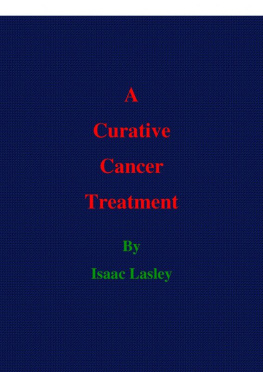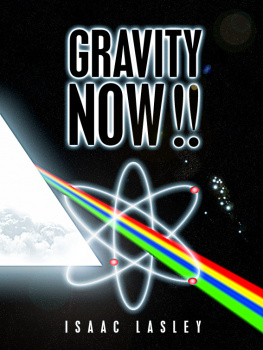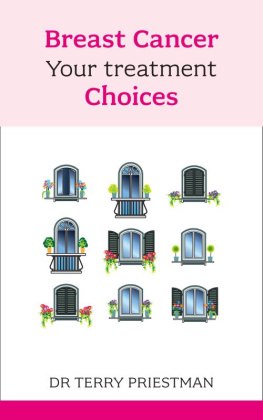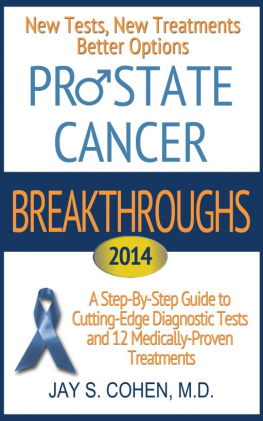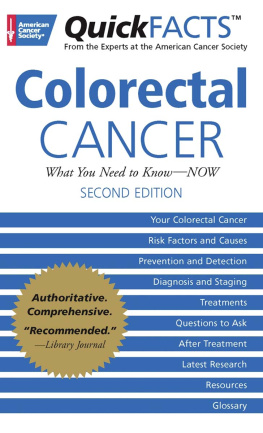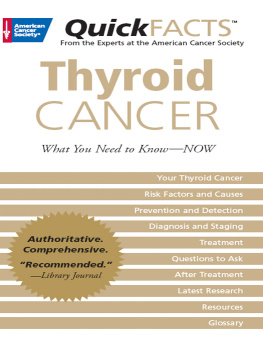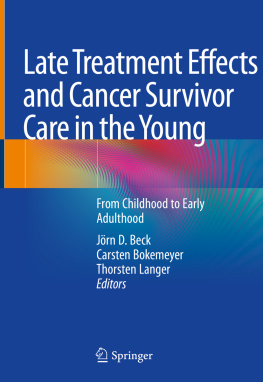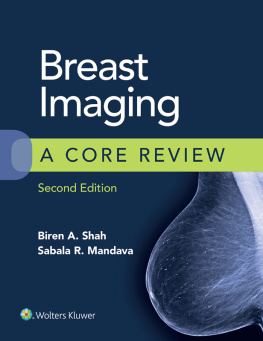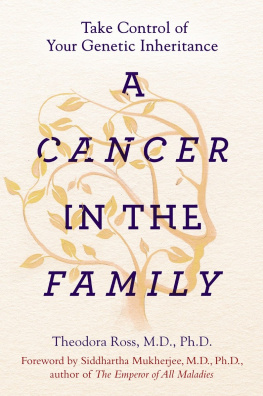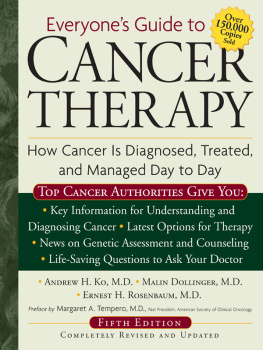A Curative Cancer Treatment
Isaac Lasley
Smashwords Edition
Copyright 2011, IsaacLasley
All Rights Reserved.
This book was written toshare my curative cancer treatment hypotheses with the world tohopefully spark a worldwide curative cancer treatment resource thatwill help to enable humanity to end its pain caused as a result ofthis terrible disease of cancer. The majority of the onlineinformational resources utilized throughout this book came from TheNational Center for Biotechnology Information and CancerGeneticsWeb. The pictures are from noted sources that have beenpublicized online.
Smashwords Edition, License Notes
This ebook is licensed for your personalenjoyment only. This ebook may not be resold or given away to otherpeople. If you would like to share this book with another person,please purchase an additional copy for each recipient. If yourereading this book and did not purchase it, or it was not purchasedfor your use only, then please return it to Sashwords.com andpurchase your own copy. Thank You for respecting the hard work ofthis author.
A Curative
Cancer Treatment
Written and Edited
By
Isaac Lasley
Copyright 2010 Isaac Lasley
Table of Contents
Introduction
I am a research scientist who studies a vastrange of fields. I wrote this book to share my curative cancertreatment with the world as it has such great potential. I mustbegin by noting my appreciation for my father, David Lasley, forlighting the fire under my ass that helped me to ever attempt tocreate a curative cancer treatment process. I must also thank Dr.Jim Bonacum, a professor of microbiology at the University ofIllinois at Springfield, for inspiring me to write this book inorder to copyright and share my ideas with the world rather thanenter my hypotheses into an inventors contest only to likelyeventually get ripped off. Jim was my inspiration for this book andbefore meeting him on that summer day in 2007 to propose myhypotheses for approval to be entered into the inventors contest Ihad never seen a mans eyes bug out of his face far enough to pushhis glasses down his nose.
As soon as this book is copyrighted by mydigital publisher Smashwords I will send a free copy of this bookand 21st Century Cancer Treatment to the leaders of every nationon the planet, as well as the USA Vice President Joe Biden, and the100 members of the United States Senate. I am a man who believesthat a relative world peace between cultures and nations around theplanet earth is possible if we can come together in order to solvethe problems that affect us all in some way. If my curative cancertreatment process is successful I look forward to seeing the worldcome together to create an international bank of curative cancertreatments, as there will in the end be thousands of them that willneed to be stored securely and reproduced as needed. I am confidentthat a relative world peace outside of the United Nations ispossible as our cultures and countries focus on our commongoals.
A Curative CancerTreatment
I believe that the time has come to endhumanitys pain and sorrow caused by cancer. I have developed acurative cancer treatment process hypothesis that has a greatpotential. In this book I will outline my hypothesis and thoughtsregarding how cancer can be flushed out of the body through propercancer cell stimulation. Each cancer type for which I will note acurative treatment was included in, with a detailed description,within the pages of my previous eBook, 21st CenturyCancer Treatment.
What IsCancer and Why Does It Occur?
What is Cancer? This question should be thefirst one asked if any person wants to find a cure for cancer. Asopposed to just treating cancer as humanity has done since therealization that cancer exists and that it is problematic forhumans. We must understand what cancer is and why it may occurbefore we can ever imagine how to curatively treat cancer.
The National Cancer Institute describescancer as a term used for disease in which abnormal cells dividewithout control and are able to invade other tissues. Cancer cellscan spread to other parts of the body through the blood and lymphsystems. There are more than 100 types of cancer most named for itsorgan/cell type. Broader types of cancer include carcinoma,sarcoma, leukemia, lymphoma, myeloma, and CNS cancers.
Carcinoma - cancer thatbegins in the skin or in tissues that line or cover internalorgans.
Sarcoma - cancer thatbegins in bone, cartilage, fat, muscle, blood vessels, or otherconnective or supportive tissue.
Leukemia - cancer thatstarts in blood-forming tissue such as the bone marrow and causeslarge numbers of abnormal blood cells to be produced and enter theblood.
Lymphoma and myeloma -cancers that begin in the cells of the immune system.
Central nervous systemcancers - cancers that begin in the tissues of the brainand spinal cord [1].
The American Cancer Society notes thatcancer is a collection of more than 100 diseases in which cells inpart of the body begin to grow out of control. Many types of cancerbegin as a result of abnormal cells growing out of control.Untreated cancers can cause serious illness or death [2].
The American Society of Clinical Oncologydescribes cancer as more than 100 diseases characterized byuncontrolled abnormal growth of cells. These cells form a lump ormass called a tumor. Some cancers, like blood cancers, dont formtumors. Tumors can be benign or malignant. Benign tumors may grow,but they do not spread to other parts of the body and are usuallynot life threatening. Malignant tumors grow and invade othertissues in the body.
Sometimes cancer will spread to the lymphnodes. A lymph node is a tiny, bean-shaped organ that filters theflow of lymph, the clear fluid that plays a role in the body'simmune system. Lymph nodes are located in clusters in differentparts of the body, such as the neck, groin area, and under thearms. Cells from malignant tumors can also break away and travel toother parts of the body, where they can continue to grow. Thisprocess is called metastasis. Metastatic cancer is named for thepart of the body where it started. For example, if breast cancerspreads to the lungs, it is called metastatic breast cancer, notlung cancer. Cancer can begin almost anywhere in the body. Tumorsare named for the type of cell where the cancer started. As,carcinomas begin in the skin or tissue that covers the surface ofinternal organs and glands. Sarcomas begin in the connectivetissue, such as muscle, fat, cartilage, or bone [3].
I can confidently say that cancer isinitially formed out of what were once normal human cells, havingidentifying DNA, that have mutated in some way to become abnormal,then mutating even more to become cancerous in nature. Thecancerous cells may be benign and cannot spread throughout the bodyto other areas; or malignant, meaning that the cells are mobile andhave the ability to spread to other areas of the body. The primarycauses of cancer include the environment in which one works orresides, personal habits, and genetic variations.
Knowing that cancer cells were at one pointnormally functioning cells of the human body that mutated to formabnormal, cancerous cells; we can more easily understand the manydifferent types of cancers that exist. Of course the two main typesof cancer can be classified as benign or malignant in nature.Cancer can also be classified as localized which means that a tumoris confined to one area, even as it may have spread to nearbytissue/organs; or as a metastic cancer which is able to spreadthroughout the entire body having reached the lymphatic system. Acarcinoma is a cancer of the skin or of the lining of internalorgans. A sarcoma begins in fat, bone, cartilage, muscle, bloodvessels, or other connective/supportive tissue. Leukemia is acancer of blood forming tissue. Lymphoma and myeloma are cancers ofthe immune system. Central nervous system cancers occur in thebrain and spinal cord. Having this understanding of cancer we knowthat it consists of what were once normal human cells that havemutated in some way, functioning improperly, and reproducing, withthe potential to cause harm to other cells of the body at somepoint if the cancer becomes malignant. Cancer cells are renownedfor dividing, multiplying, and conquering other healthy human cellsas the immune system has failed to recognize the cancer cells asforeign cells since they started as once healthy human cells or theimmune response was simply ineffective. In short cancer cells caninitially be noted as once normal cells that have mutated as aresult of genetic inheritance or environmental/outside factors.
Next page
